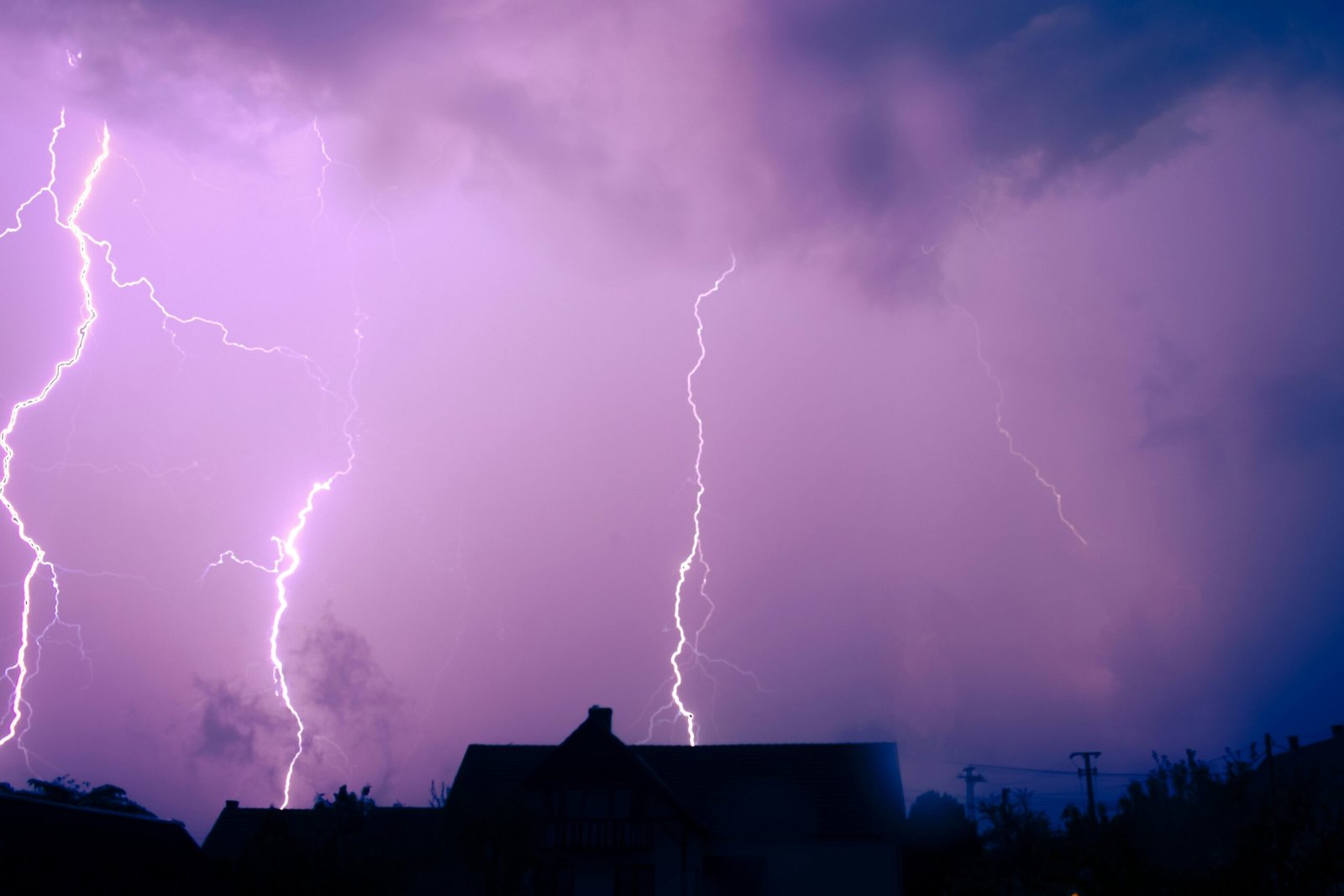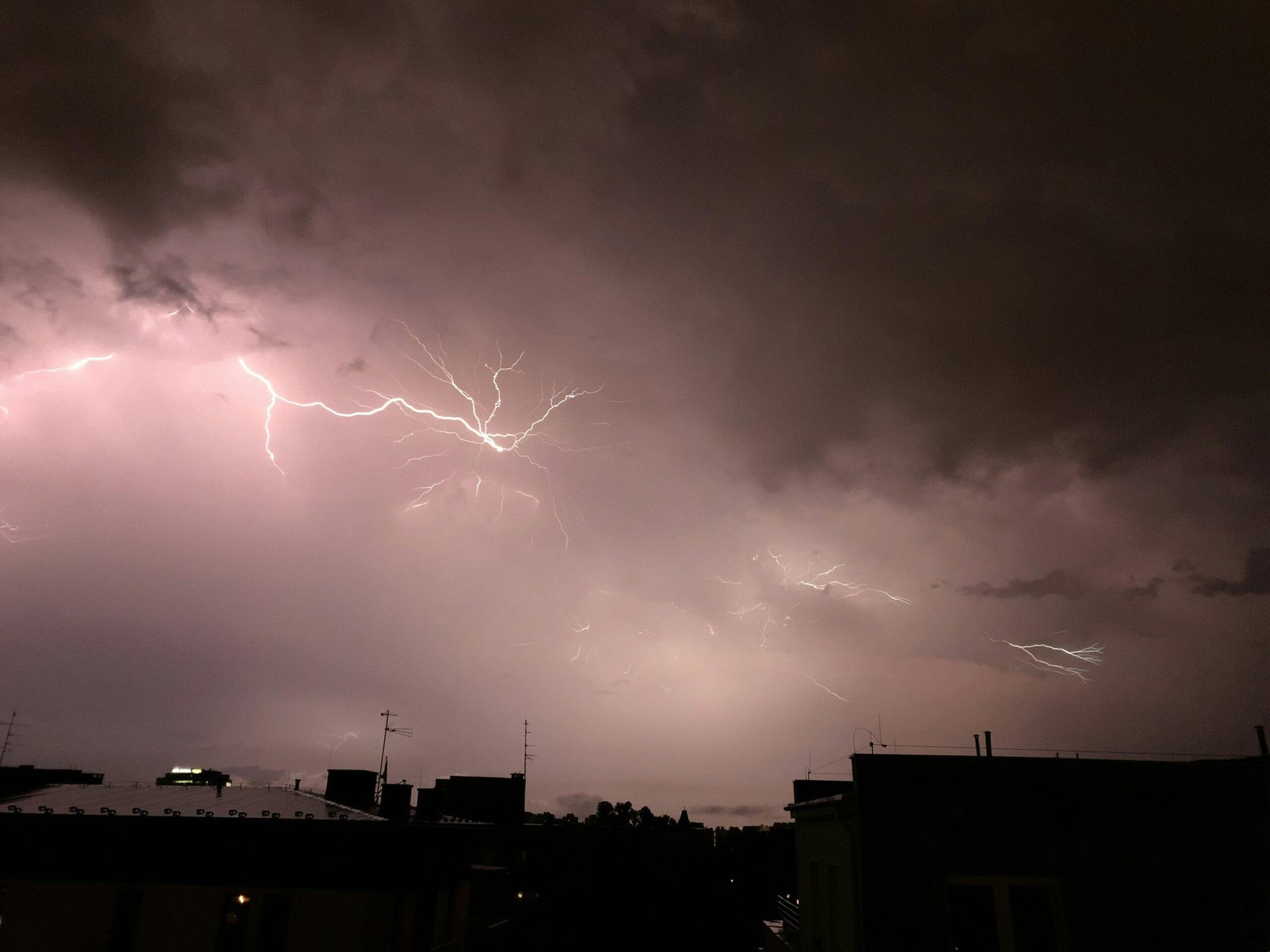Current Weather Conditions in St. Louis
As of March 30, 2025, St. Louis is experiencing fluctuating weather conditions that have raised concerns among residents about the potential for severe storms. The day began with a significant cloud cover, obscuring the sun and contributing to a cooler atmosphere. Early morning temperatures were recorded around the mid-50s Fahrenheit, but with the expectation of rising throughout the day, this fluctuation indicates the potential for instability in the atmosphere, which is a precursor to severe weather conditions.
Forecasters have highlighted the likelihood of thunderstorms developing as the day progresses, with models indicating that conditions may become favorable for intense weather activity by the afternoon. Residents should remain alert, as the National Weather Service has issued a severe thunderstorm watch for the area, categorizing the risk level as noteworthy. The possibility of heavy rainfall is particularly concerning, as accumulations could quickly lead to localized flooding across low-lying areas of the city.
More information Severe Weather Alert: March 31, 2025 – What You Need to Know
Severe Weather Alert: March 31, 2025 – What You Need to KnowMoreover, there is a severe risk of hail and tornado development associated with this storm system. Meteorologists are monitoring the atmosphere closely, as wind shear and instability are evolving factors that raise the risk of tornadoes. It is vital for residents to have a safety plan in place, which may include securing outdoor items, ensuring access to emergency kits, and staying informed through local news or weather apps. Vulnerable areas prone to flooding should be approached with caution, and everyone should heed any warnings or advisories issued by local authorities throughout this weather event.
Forecast Overview for the Coming Week
The weather forecast for St. Louis in the upcoming week indicates a series of atmospheric disturbances that could lead to severe weather conditions, including tornado threats, hail, and significant rainfall. Starting from Monday, residents can expect temperatures ranging from the mid-60s during the day to the low 40s at night. A cold front will approach the area, likely bringing scattered rain showers, especially in the evening hours.
On Tuesday, the weather will shift significantly as a low-pressure system moves through the region. This could lead to increased instability, creating favorable conditions for thunderstorms. High temperatures will peak in the upper 70s, with potential severe thunderstorms generating heavy rain and strong winds. The severe weather could include hail, which poses risks to both property and personal safety.
More information Tropical Storm Rafael Forms in the Caribbean: What You Need to Know
Tropical Storm Rafael Forms in the Caribbean: What You Need to KnowBy midweek, around Wednesday, temperatures will cool slightly with highs in the low 70s, as the system moves out. However, lingering instability may still lead to isolated thunderstorms, particularly in the afternoon. Residents are encouraged to stay alert as the National Weather Service will provide updated alerts regarding any severe thunderstorm warnings.
As the workweek comes to a close, Thursday and Friday are expected to be markedly warmer, with highs approaching the 80s. Nevertheless, another round of storms is anticipated later on Friday, increasing the already present flood risk from earlier precipitation. It is important to monitor weather updates frequently, as conditions can change rapidly. The weekend outlook suggests a return to more stable weather patterns, marking a temporary reprieve from the potential threats of severe weather.
Consulting with the National Weather Service remains crucial for obtaining the most accurate and timely information regarding the rapidly evolving weather conditions in St. Louis.
More information Tropical Storm Rafael: Impact and Predictions for the Caribbean and Florida Keys
Tropical Storm Rafael: Impact and Predictions for the Caribbean and Florida KeysSevere Weather Alerts and Warnings
As St. Louis prepares for the possibility of severe storms, it is crucial for residents to remain informed about the potential risks posed by tornadoes, large hail, and heavy rainfall. The National Weather Service (NWS) has issued specific alerts to delineate the areas most vulnerable to these hazardous conditions. This proactive communication is essential, as it assists communities in preparing for potential emergencies.
In recent forecasts, weather authorities have pinpointed a number of counties within the St. Louis metropolitan area that may face heightened storm activity. The alerts include tornado watches and severe thunderstorm warnings that indicate conditions are favorable for the development of these dangerous weather phenomena. Residents in the affected regions are urged to have a safety plan in place, acknowledging that the duration of severe weather may span several hours, contributing to varying levels of threat.
Monitoring updates from local meteorologists and the NWS is imperative. Many severe storms can escalate quickly, and timely information can make a difference in ensuring safety. Social media channels, weather apps, and radio broadcasts are all valuable resources that can provide real-time updates and alerts. It is also advisable for individuals to familiarize themselves with emergency protocols, including safe spots within homes or workplaces and the necessary supplies to weather a storm.
More information Winter Weather Update: First Measurable Snowfall of the Season in Wisconsin
Winter Weather Update: First Measurable Snowfall of the Season in WisconsinThe potential for large hail poses additional risks, as it can cause significant damage to property and vehicles. Residents should consider safeguarding their belongings and assess outdoor structures to minimize potential damage. As storm predictions evolve, adapting to the latest alerts will remain critical to maintaining community safety during this turbulent weather period. Awareness and preparedness will mitigate the risks associated with severe storms, ensuring residents are equipped to respond effectively.
Resources for Weather Updates
As St. Louis prepares for the potential onslaught of severe weather events, including tornadoes, hail, and flooding, it is crucial for residents to access reliable weather updates. There are several trusted resources available that provide real-time information, forecasts, and alerts to help the community stay informed and safe.
One of the foremost resources is AccuWeather. This platform offers comprehensive weather updates, including detailed forecasts, interactive radar maps, and severe weather alerts. Users can access location-based information, which is particularly useful in tracking impending storms. Additionally, AccuWeather features an easily navigable mobile app that sends push notifications for any severe weather alerts in the vicinity, allowing residents to prepare in advance.
More information Understanding the Tornado Watch: Recent Developments and Weather Trends
Understanding the Tornado Watch: Recent Developments and Weather TrendsAnother key resource is KSDK, the local NBC affiliate. KSDK provides in-depth coverage of the weather, featuring live reports and updates from meteorologists who specialize in the St. Louis area. Their website and app include detailed radar maps, video forecasts, and severe weather warnings. Residents can benefit from KSDK’s live streaming capabilities during storm events, offering a real-time connection to essential information.
The Weather Channel is also a critical tool for those looking to stay updated on severe weather conditions. It provides extensive coverage of national and local forecasts, as well as radar imagery. Users can utilize the interactive features to visualize storm paths and warning zones. Furthermore, the Weather Channel’s app allows users to customize alerts based on their locations, ensuring timely communication about severe weather threats.
Staying informed through these resources can significantly enhance preparedness before severe weather strikes. By utilizing AccuWeather, KSDK, and The Weather Channel, St. Louis residents can access timely weather updates and take necessary precautions to ensure their safety during adverse weather conditions.
Understanding Severe Weather Risks
Severe weather poses significant risks to communities, particularly in areas prone to tornadoes, hail, and flooding. Understanding these risks is essential for residents to prepare and respond effectively when extreme weather events occur. Tornadoes are among the most violent of thunderstorms, capable of producing disastrous winds exceeding 300 miles per hour. These rotating columns of air can devastate structures, uproot trees, and lead to severe injuries or fatalities. The impacts of tornadoes are not just immediate; the recovery phase can stretch for months or even years, significantly affecting communities.
Hail, another severe weather risk, can cause extensive damage to crops, vehicles, roofs, and outdoor infrastructure. Hailstones vary in size, with larger stones potentially reaching the size of softballs. This unpredictability in size and intensity makes hail damage particularly concerning, particularly for agriculture-dependent regions. The economic implications of hail events can be profound, often leading to costly repairs and losses in agricultural yield.
Flooding presents a different set of challenges and risks. Excessive rain, often linked to severe thunderstorms or tropical systems, can lead to flash flooding, which is particularly dangerous due to its sudden onset. Factors such as soil saturation, urban development, and topographical features influence flooding severity. In areas like St. Louis, where rainfall can accumulate rapidly, understanding local flood zones and warnings can be lifesaving. Floodwaters can compromise infrastructure, contaminate drinking water, and pose health risks to affected communities.
In light of these threats, it is critical for residents to stay informed through local weather forecasts and emergency preparedness resources. Understanding the risks associated with severe weather can empower individuals to take proactive measures to protect themselves and their properties while ensuring community resilience in the face of such unpredictable natural events.
Safety Precautions for Residents
As St. Louis braces for the impending threats of severe weather, it is crucial for residents to take proactive measures to ensure their safety. The forecast, predicting the potential for tornadoes, hail, and flooding, necessitates a comprehensive approach to preparation and response. The first step residents should undertake is to stay informed about weather updates through reliable sources, including the National Weather Service, local news outlets, and weather apps. Timely information will enable individuals to make quick decisions about personal safety and necessary actions.
Developing a shelter plan is also essential. Residents should identify a safe location, preferably in the lowest level of their property, such as a basement or an interior room without windows, where they can seek refuge during severe storms or tornado warnings. It is advisable to have an emergency kit ready, including supplies such as water, non-perishable food, flashlights, a first-aid kit, and crucial medications. This kit should be easily accessible in the event of sudden and severe weather conditions.
Another important precaution is to avoid flood-prone areas and be vigilant against the potential for flash flooding during heavy rains. Residents should refrain from attempting to drive through flooded roads, as even shallow water can pose significant dangers. Creating a plan for evacuation, should the need arise, is also prudent; this includes familiarizing oneself with routes to higher ground and keeping an emergency contact list handy.
Additionally, it is advisable to secure outdoor items that could become projectiles during high winds and to ensure that gutters and drains are clear of debris to facilitate proper water drainage. By meticulously preparing for severe weather, St. Louis residents can enhance their safety and mitigate threats associated with this challenging season.
Community Preparedness and Response Tips
As St. Louis braces for severe weather, including tornadoes, hail, and potential flooding, it is imperative that communities come together to enhance preparedness and response efforts. A proactive approach can significantly reduce the impact of such weather events and foster resilience within neighborhoods. One effective way to ensure community readiness is to establish communication networks among neighbors. This can include phone trees, social media groups, or neighborhood apps that serve to disseminate timely information.
Local organizations, such as neighborhood watch groups, can play a crucial role in coordination during emergencies. These groups often have established relationships with local authorities and can act as liaisons to share weather-related updates and risk assessments. Furthermore, community centers often provide resources and shelter during severe weather events. Residents should familiarize themselves with these locations and their procedures for serving individuals during emergencies.
Ability to offer assistance is another pillar of community response. Neighbors can organize volunteer groups to check on vulnerable populations, such as elderly individuals or those with disabilities, ensuring their safety and access to necessary resources. Collectively creating emergency kits that contain food, water, first aid supplies, and other necessities can aid families in need as well.
Additionally, education on severe weather preparedness is vital. Communities may benefit from organizing workshops that teach citizens how to properly respond to different weather phenomena, such as identifying safe spaces during tornadoes or utilizing sandbags to mitigate flooding. Collaboration with local emergency management agencies for these educational initiatives can further enhance community understanding and resilience.
By fostering a culture of preparedness and cooperation, St. Louis residents can not only safeguard themselves and their families but also strengthen communal bonds, ensuring that everyone is better equipped to weather the storms ahead.
Historical Context of Severe Weather in St. Louis
St. Louis, Missouri, has a long and intricate history regarding severe weather events, notably tornadoes, hailstorms, and flooding. Located near the confluence of the Mississippi and Missouri Rivers, this metropolitan area is particularly susceptible to such phenomena due to its geographical position and climatic conditions. Historical records indicate that St. Louis experiences an average of 2 to 3 tornadoes per year, however, significant outbreaks have been documented, including the infamous F4 tornado in 1959 which resulted in considerable damage and loss of life.
In addition to tornadoes, hailstorms also pose a considerable threat to the St. Louis area. Instances of large hailstones, sometimes exceeding two inches in diameter, have been recorded. These events can cause extensive damage to vehicles, roofs, and vegetation, making it essential for residents to be vigilant and prepare accordingly. The patterns observed in past hailstorm occurrences have indicated a tendency for such events to peak during the late spring and early summer months, aligning with the prevailing climatic conditions at that time.
Flooding is another historical concern for the residents of St. Louis. The city’s location along major river systems underscores its vulnerability to heavy rainfall and resultant flooding. Notable flooding events in history include the 1993 Great Flood, which resulted in significant economic losses and prompted major changes in flood management policy and infrastructure. Such historical insights emphasize the importance of preparedness among residents and local authorities alike, as these severe weather trends are likely to persist. By understanding the historical context of severe weather in St. Louis, communities can better strategize on how to mitigate the impacts of future weather-related threats.
Conclusion and Final Thoughts
In light of the current trajectory of severe weather patterns affecting St. Louis, it is imperative for residents to remain vigilant. The impending threats of tornadoes, hail, and flooding require a proactive approach to ensure safety. Throughout this blog post, we highlighted the critical aspects of these severe weather phenomena, including their sudden onset and the potential for significant damage. As weather alerts become imminent, residents should ensure they are adequately informed and prepared to take necessary actions.
Monitoring local weather channels and utilizing weather apps can provide timely information regarding storm warnings and updates. Furthermore, being aware of community resources such as shelters and emergency services can be invaluable in times of crisis. It is essential for individuals and families to have an emergency plan in place, which includes a communication strategy, essential supplies, and designated safe locations to seek shelter. Practicing preparedness can greatly mitigate risk during unpredictable weather events.
Moreover, community engagement plays a vital role in ensuring collective safety. Neighbors should communicate and share information, reinforcing a support system that can respond effectively to adverse weather conditions. Schools, businesses, and local organizations should invest in training and resources to safeguard their staff and students during severe weather threats. As we anticipate these impending storms, prioritizing safety in daily routines is crucial.
By taking these precautions seriously and remaining alert to updates, residents of St. Louis can protect themselves and their communities from the hazards posed by severe weather. Ultimately, preparedness and awareness are key to navigating the challenges that lie ahead.




